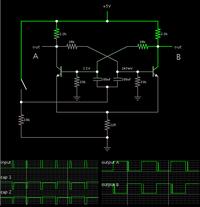rajaram04
Advanced Member level 3

Hello sir
I found a link explaning a T flip flop using transistors with the circuit diagram shown below with link
https://electriciantraining.tpub.com/14181/css/14181_124.htm

please tell me here . . is the circuit ok ???????
What are the components value i should apply could you please explain ?
i am too having doubt on transistor type cause it is using pnp one & we all know about bi-stable design well
I found a link explaning a T flip flop using transistors with the circuit diagram shown below with link
https://electriciantraining.tpub.com/14181/css/14181_124.htm

please tell me here . . is the circuit ok ???????
What are the components value i should apply could you please explain ?
i am too having doubt on transistor type cause it is using pnp one & we all know about bi-stable design well
Last edited:


